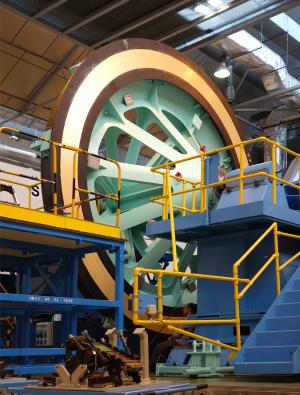Magnetic system
Six rings to counter the force
20 Nov 2017
Work on the pre-compression rings of the ITER magnet system is progressing in Europe, where work on a full-scale prototype is underway. These technically challenging components—made of composite materials—are designed to push back against the electromagnetic forces of the ITER machine and reduce the fatigue on the structures of the toroidal field magnets.
At Airbus Defence and Space in Madrid, a pre-compression ring "slice" undergoes testing. Well-established aerospace techniques have been useful for the prototype activities on ITER's pre-compression rings, which are certainly the largest composite structures ever designed for use in a cryogenic environment. © AIRBUS D&S Spain
The electromagnetic forces acting on the machine structure during operation will be huge—to the order of several hundred meganewtons (MN). Caused by electromagnetic interaction between the toroidal field coil current and the magnetic field generated by the poloidal field coils, these out-of-plane forces will cause stress to the toroidal field coils and, over time, fatigue.
Six pre-compression rings, installed at the top and bottom of the toroidal field coils, will be used to pull the 18 coils tightly together. Measuring five metres in diameter and weighing approximately three tonnes, the pre-compression rings will reduce the fatigue on the magnet structures caused by electro-magnetic forces—consequently prolonging their operational lifetime. Three other rings will be manufactured as spares.
A lengthy R&D program carried out in Europe identified a glass-fibre/epoxy composite as the best material for withstanding high loads and avoiding the circulation of current; the fiberglass composite rings, consisting of more than a billion miniscule glass fibres, will be glued together by a high-performance epoxy resin.
Work is underway at Airbus Defence and Space (Airbus D&S) in Madrid, Spain, on a full-size prototype—part of advanced qualification activities that precede the start of production. Development of the spare pre-compression rings is taking place at CNIM in Toulon, France, where a small-scale mockup is in production.
Read the full article on the European Domestic Agency website.


